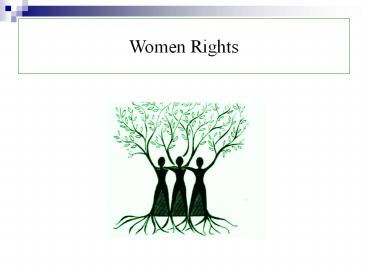Women Rights - PowerPoint PPT Presentation
Title:
Women Rights
Description:
Women Rights The term women's rights The term women's rights refers to freedoms and entitlements of women and girls of all ages. These rights may or may not be ... – PowerPoint PPT presentation
Number of Views:980
Avg rating:3.0/5.0
Title: Women Rights
1
Women Rights
2
(No Transcript)
3
The term women's rights
- The term women's rights refers to freedoms and
entitlements of women and girls of all ages. - These rights may or may not be
institutionalized, ignored or suppressed by law,
local custom, and behavior in a particular
society. These liberties are grouped together and
differentiated from broader notions of human
rights because they often differ from the
freedoms inherently possessed by or recognized
for men and boys, and because activists for this
issue claim an inherent historical and
traditional bias against the exercise of rights
by women and girls. - Issues commonly associated with notions of
women's rights include, though are not limited
to, the right to bodily integrity and autonomy
to vote (suffrage) to hold public office to
work to fair wages or equal pay to own
property to education to serve in the military
or be conscripted to enter into legal contracts
and to have marital, parental and religious
rights.Women and their supporters have campaigned
and in some places continue to campaign for the
same rights as men.
4
(No Transcript)
5
The Middle Ages
- According to English Common Law, which developed
from the 12th Century onward all property which a
wife held at the time of a marriage became a
possession of her husband. Eventually English
courts forbid a husband's transferring property
without the consent of his wife, but he still
retained the right to manage it and to receive
the money which it produced. "French married
women suffered from restrictions on their legal
capacity which were removed only in 1965." In the
16th century, the Reformation in Europe allowed
more women to add their voices, including the
English writers Jane Anger, Aemilia Lanyer, and
the prophetess Anna Trapnell. Despite relatively
greater freedom for Anglo-Saxon women, until the
mid-nineteenth century, writers largely assumed
that a patriarchal order was a natural order that
had existed. This perception was not seriously
challenged until the eighteenth century when
Jesuit missionaries found matrilineality in
native North American peoples
6
The Enlightenment
- In the late 18th Century the question of women's
rights became central to political debates in
both France and Britain.
7
Suffrage, the right to vote
- During the 19th Century women began to agitate
for the right to vote and participate in
government and law making. The ideals of women's
suffrage developed alongside that of universal
suffrage and today women's suffrage is considered
a right (under the Convention on the Elimination
of All Forms of Discrimination Against Women). - During the 19th Century the right to vote was
gradually extended in many countries and women
started to campaign for their right to vote. In
1893 New Zealand became the first country to give
women the right to vote on a national level.
Australia gave women the right to vote in 1902,
while the USA, Britain and Canada gave women the
vote after the First World War.Sweden would also
be a contestant as the first independent nation
to grant women the right to vote. Conditional
female suffrage was granted in Sweden during the
age of liberty (17181771)
8
(No Transcript)
9
Modern movement
- In the subsequent decades women's rights again
became an important issue in the English speaking
world. By the 1960s the movement was called
"feminism" or "women's liberation." Reformers
wanted the same pay as men, equal rights in law,
and the freedom to plan their families or not
have children at all. Their efforts were met with
mixed results. - In the UK, a public groundswell of opinion in
favour of legal equality had gained pace, partly
through the extensive employment of women in what
were traditional male roles during both world
wars.
10
- Over the course of the 20th century women took on
greater roles in society such as serving in
government. In the United States some served as
U.S. Senators and others as members of the U.S.
Cabinet. Many women took advantage of
opportunities in higher education. In the United
States at the beginning of the 20th century less
than 20 of all college degrees were earned by
women. By the end of the century this figure had
risen to about 50. - Progress was made in professional opportunities.
Fields such as medicine, law, and science opened
to include more women. At the beginning of the
20th century about 5 of the doctors in the
United States were women. As of 2006, over 38 of
all doctors in the United States were women, and
today, women make almost 50 of the medical
student population. While the numbers of women in
these fields increased, many women still
continued to hold clerical, factory, retail, or
service jobs. For example, they worked as office
assistants, on assembly lines, or as cooks
11
(No Transcript)
12
Convention on the Elimination of All Forms of
Discrimination Against Women
- The Universal Declaration of Human Rights adopted
in 1948, enshrines "the equal rights of men and
women", and addressed both the equality and
equity issues. In 1979 the United Nations General
Assembly adopted the Convention on the
Elimination of All Forms of Discrimination
against Women (CEDAW )
13
(No Transcript)
14
(No Transcript)































